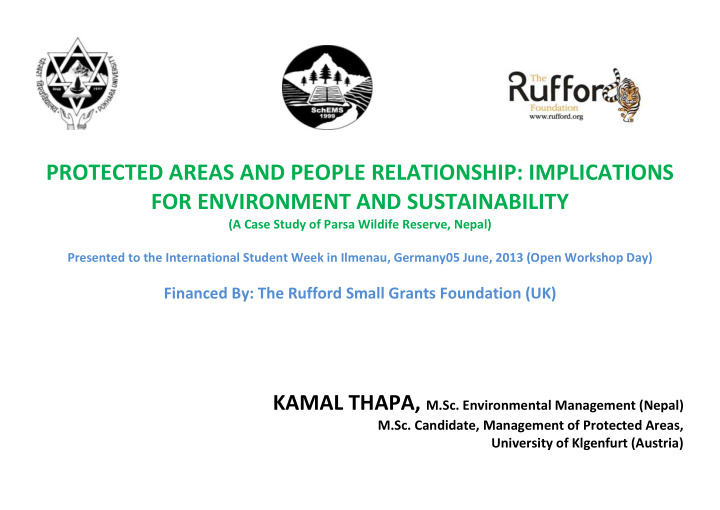



PROTECTED AREAS AND PEOPLE RELATIONSHIP: IMPLICATIONS FOR ENVIRONMENT AND SUSTAINABILITY (A Case Study of Parsa Wildife Reserve, Nepal) Presented to the International Student Week in Ilmenau, Germany05 June, 2013 (Open Workshop Day) Financed By: The Rufford Small Grants Foundation (UK) KAMAL THAPA, M.Sc. Environmental Management (Nepal) M.Sc. Candidate, Management of Protected Areas, University of Klgenfurt (Austria)
Introduction • PAs are, ‘‘clearly defined geographical space that is recognized, dedicated and managed through the legal and other effective means to achieve the long term conservation of nature with associated ecosystem services and cultural values’’ (Dudley,2008). • PAs means a ‘‘geographically defined area which is designated or regulated and managed to achieve specific conservation objectives’’ (CBD). • PAs are the store house of bio-diversity worldwide and also the key elements in climate change mitigation strategies and shelter the threatened human communities and/or sites of cultural and spiritual values (Dudley, 2008; Getzner et al., 2012).
Growth in number of nationally and internationally designated Protected Areas ( IUCN and UNEP-WCMC, 2012)
Growth in nationally designated Protected Areas by area (IUCN and UNEP-WCMC, 2012)
IUCN Categories of PAs • Category 1 a –Strict Nature Reserve • Category 1 b –Wilderness Area • Category 2 –National Park • Category 3 –Natural Monument • Category 4 –Habitat/Species management area • Category 5 –Protected Landscapes/Seascapes • Category 6 –Managed Resource Protected Area CBD targets 2020: at least 17 % of terrestrial and inland water & 10 % of coastal and marine areas are conserved and integrated into the wider landscapes and seascapes.
Study Site
Growth in Protected Area coverage in Nepal by area (includes both PA and BZ) ( DNPWC, 2010)
Nepalese Categories of PAs PAs Type Numbers % of Nepal’s % of PAs Area Area National Park 10 7.37% 31.58% Wildlife Reserve 3 0.66% 2.84% Hunting Reserve 1 0.90% 3.85% Conservation Area 6 10.48% 44.88% Buffer Zone 12 3.92% 16.82% Total 32 23.3% 99.97%
CASE STUDY: Parsa Wildlife Reserve, Nepal • PAs has played significant role in the conservation of biodiversity but restrictions in using park resources. • Human harassment or killings, crop damage and livestock depredation has brought negative sentiments towards PAs (Shrestha, 1996; Allendorf et al., 2007). • Approaches of biodiversity conservation: fortress and fine conservation, participatory conservation, and landscape conservation (Baral, 2005). • Local people were de facto free to collect natural resources before the establishment of PAs.
• Local communities have threatened PAs by poaching and causing habitat loss through encroachment into protected areas (Shrestha, 1996; Weldajiand Tchamba, 2003; Gupta 2005). • The NPWC act (1973), CAMR (1996) and BZMR (1996)
Research Findings
Respondents by Level of Education
Attitude towards Buffer Zone
Attitude towards PWR Response towards buffer and buffer zone zone user group
Response (%) Conservation statement SA A N D SD Mean±S.D. Buffer zone area was created for the 6.77 33.89 42.37 13.55 3.38 3.43 0.79 betterment of our locality Buffer zone programme has helped us to support 1.69 35.59 28.81 28.81 5.08 2.77 0.87 our livelihoods and community development I am happy to be included in the Buffer Zone are 0 42.37 37.28 16.94 3.38 3.43 0.97 I like the presence of Reserve nearby my village 3.44 31.03 25.86 32.75 6.89 3.22 1.06 People and livestock/crops are more important 1.72 31.03 36.20 24.13 6.89 3.51 0.70 than saving forests or wildlife My living condition improved after the creation 3.44 43.10 20.68 25.86 6.89 2.58 0.99 of Reserve Wildlife damage compensation received from 8.47 10.16 16.94 22.03 42.37 1.72 0.81 reserve/government is sufficient It is important to set aside a place for the animals 3.44 70.68 18.96 6.89 0 3.72 0.69 and plants to live in I am satisfied with the functioning of BZUG/BZUC 3.44 41.37 31.03 22.41 1.72 3.22 0.91 You are willing to contribute for bio-diversity 46.55 46.55 5.17 1.72 0 4.37 0.67 conservation.
Factors Affecting Attitudes towards PWR and BZ
Percentage of loss (by HWC issues and wildlife induced amount) for each crop damage due to wildlife Animal liable to Crop damage damage Elephant ( Elephas Maize, Rice, Wheat maximus) Cheetal (Axis axis) Maize, Rice, Millet, Lentil, Mustard Boar (Sus scrofa) Maize, Rice, Wheat, Mustard Porcupine (Hystrix Maize, Rice indica) Blue Bull (Boselaphus Lentil, Mustard tragocamelus)
Natural Resources Used by Respondents Natural Respondents Percentage Resources Fodder 21 36.25% Fuel wood 49 84.48% Thatch grass 6 1.03% Leaf litter 16 27.58% Medicinal herbs 0 0% Edible plants 1 1.72% Timber 2 3.44% Others 2 3.44%
Fuel Wood Use Average fuel wood use by the local residents is 444.51 kg/capita/year (2969.32 kg/hh/year OR 2.96 ton/hh/year)
Implications for Environment and Sustainability • PA and People can not be separated from each other • Ecosystem services provided by PA has livelihood significance
• Enhanced PA mgmt. can meet both the needs and secure biodiversity conservation • PAs help in carbon sequestration, climate change adaptation, flood control and so on. • Poverty as threat to sustainable PA mgmt.
Conclusion • Overall, the attitude of local people was found to be negative. • The absence of conservation intervention programme and community development activities created negative attitude towards BZ & reserve. • Wildlife induced damage to the local people in the form of crop /livestock depredation and property damage brought park people conflicts.
Recommendation • CBC approach and local people participation in decision making process is likely to improve residents’ attitudes towards PA. • Alternative resources should be promoted that helps to address resource deficiency. • Knowledge and information exchange and extension and communication programme must be the regular part of reserve management. • Wildlife damage compensation policy must be revised timely to address the level of damage and to compensate accordingly. • Site specific conservation strategy must be developed and implemented.
Thank You! Email: thekamal@gmail.com
Recommend
More recommend